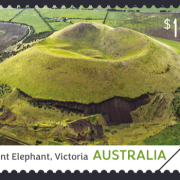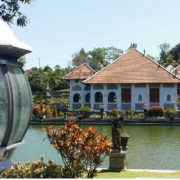Limbo: Jungle bars, volcanic interruptions
Above: OzPost’s Mt Elephant volcano stamp issue
Volcano watch wasn’t exactly what I’d planned. Things were meant to be more of an exploration mission. A search for faces, places, swimming pools, sort of stuff you do in the Bali tropics.
Ideally, it was going to be a search for jungle bars.
Something in the treetops, or nestled into a river gorge cliff face, maybe on the edge of python-riddled rice terrace. Bit of lazy exploring. There was a hippy Geelong expat I hoped to track down in one.
Things went sideways, predictably enough. The expat had gone to God, hanged himself in bankruptcy, I sadly learned. One bar I tracked down was riddled with sculptures of 200 rampant monkeys, and I mean rampant. Some artisan presumably had an awkward time explaining to the missus what he’s been doing at work. “Making LGBTI anthropoids for the tourists, darling.” Hmmm.
pH levels in the first swimming pool bar left me tingling at antihistamine level. Eyes red and skin itching for days. First mates I made in a bar, sideways on margeritas — and I’m guessing lithium, too — were great fun but also looking for a political argument, no matter how many times I agreed with them. Others were paranoid.
And then volcano ash grounded all the planes in and out of Bali.
Struck me the book I was reading, a biog of explorer Hamilton Hume, who ventured into Geelong back in 1825, with his arch-nemesis William Hovell, was a good pairing. Things didn’t go quite as planned for them, either.
Thought they were at Westernport Bay. Hovell wasn’t the greatest navigator, of course; sunk one ship and ran another aground while working as a sea captain. How he got the exploring gig’s a good question.
Not that this intrepid pairing made it to the extensive volcanic areas immediately west of Geelong.
It was up to subsequent pioneers to discover the dormant volcanoes Mount Duneed, Mount Moriac and Mount Pollock right next door. Over time, the count expanded to some 400 volcanoes on an explosive arsenal across western Victoria.
About a dozen have blown their stack in the last 20,000 years or so, a minor blip in geological terms. Thing is, according to experts like Melbourne Uni’s professor Bernie Joyce, a fresh volcanic blast could erupt any time. In blip terms, we’re overdue for one.
Bernie nominates Anakie as a likely site. Yikes. Moreover, he says disaster services aren’t prepared for it – nor, I suspect, are tourism operators who might find visitors to the Great Ocean Road kept at bay by volcanic ash.
Volcano limbo is a curious thing, you know. Distracted as I was from my boozy-exploring terms of reference, I found myself tripping over all sorts of unexpected things.
People mainly. Frenzied taxidrivers, Hindu temple pilgrims, a sitar-playing prog-rocker, a failed businessman hiding out, kids in rockstar apartments, parachutists and BASE jumpers, lonely Eat Pray Love devotees, mad Aussie footy fans.
Not a one of them cared a bugger-me for the volcanic ash flight crisis. Stay there, go home, all the same to them. Nothing they could do.
Go figure. Looking for a rainforest bar and you find some nonchalant breed of couldn’t-care-less fatalism instead. Worry you die, don’t worry you still die.
Sounds like the law of the jungle. Instructional maybe. You could get eaten tomorrow. If you don’t get atomised when some mountain god cracks the sads, of course.


